Note: this page contains many images and may take a few moments to load in its entirety.
Table of contents
- Preface
- Getting There
- Itinerary
- Daily highlights (and a mystery is finally solved!)
- Day 1: Arusha to Ngorongoro Crater - game drive - Rhino Lodge
- Day 2: Rhino Lodge to Ndutu - all day game drive
- Day 3: Nudtu - game drive
- Day 4: Ndutu - game drive
- Day 5: Ndutu - game drive
- Day 6: Ndutu - game drive - Ngorongoro Crater exit
- Day 7: Ngorongoro Crater exit - to Arusha - to Nairobi
- Summary
- Game drive conditions
- Camera equipment and usage
- Final thoughts
Preface
Back to the topI encourage everyone to read my blog post entitled "Safaris can be boring... so do something about it!". It compliments this blog entry very well and addresses the monotonous moments of a safari. Here's a sample:
Serendipitous moments are few and far between while on safari. Moreover, if you've been to Africa on numerous occasions, you become even pickier from a photography perspective (which can be disheartening for your guide, but that's another story altogether).
So what's a photographer to do if he/she is in a jeep for 14 hours a day without a terrible amount of exciting moments? My advice is to look around: what looks commonplace and uninspiring may actually be quite fascinating, especially the road behind you for the landscape photographers out there.

Sunset in the Serengeti
Also, please note that not all pictures from the trip are on this page. To see the entire set, please visit my Tanzanian collection page.
Getting there
Back to the topLike many travellers, I arrived in Arusha (Tanzania) by way of Nairobi (Kenya). This time however, instead of flying to Arusha, I decided to take a bus. The reason behind my decision is fairly practical and pragmatic (and certainly not as efficient as flying): the likelihood of being asked to gate-check my camera bag when flying on a smaller aircraft is always uncomfortably high and many of the aircraft that fly between the two cities are on the diminutive side. Why travel thousands of miles only to damage your equipment with only 400 kilometers left to go?
So shortly after arriving in Nairobi, I met up with Aaron Rodericks, a fellow Canadian photographer who decided at the last minute to come to Africa with me. We waited a couple of hours and eventually boarded the bus to Arusha.
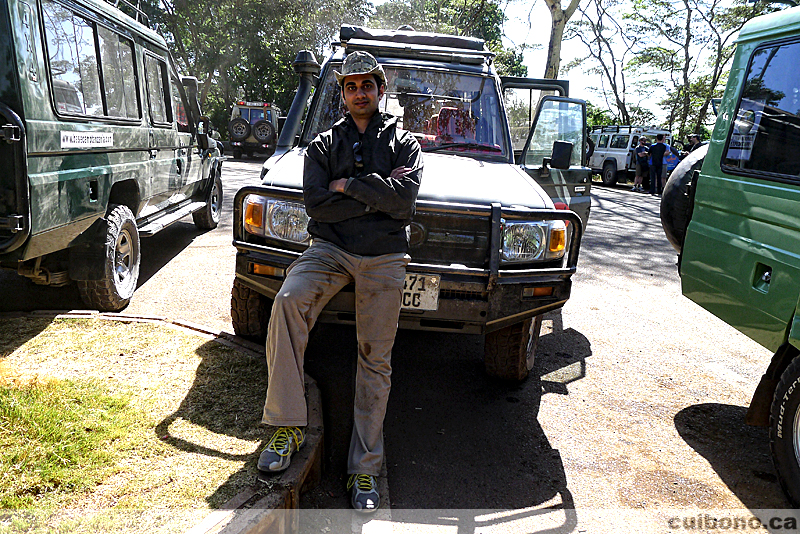
Aaron Rodericks
Everything was on schedule until we arrived at the Kenyan-Tanzanian border: a quick administrative passport and visa check became a lengthy affair for some reason. The delay didn't really matter though since the plan once in Arusha was to meet up with Godwin (our local driver/guide) and to get to bed as soon as possible.
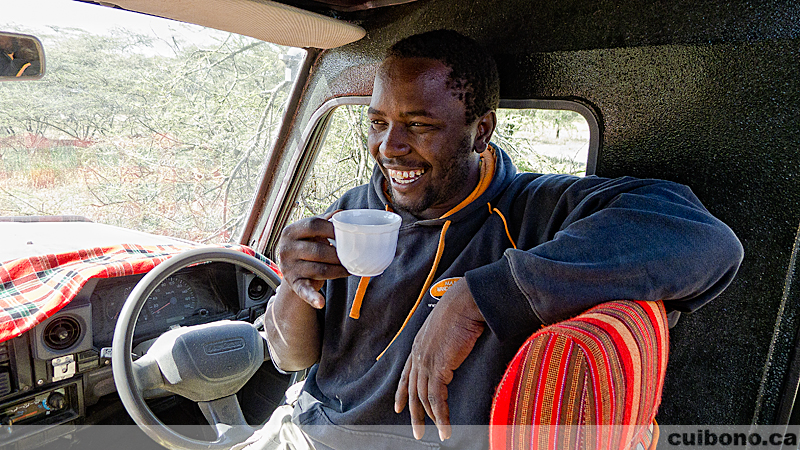
Godwin Ngushway
Aaron and I eventually arrived at our bus stop, quickly jumped into Godwin's jeep and made our way to the Ahadi Lodge. The lodge was comfortable and the service was great but after 40 straight hours of traveling to Arusha, all I really wanted at this point was a bit of good food and a clean bed. The lodge fulfilled its role.
Additional thoughts:
- If you have a lot of equipment and/or are looking for ways to save, consider taking the bus. A return ticket is roughly $50 USD and one of the pickup and drop off locations in Nairobi is Jomo Kenyatta International Airport (NBO).
- Airline food isn't usually great but you can typically recognize what's in front of you. This isn't the case on Virgin Atlantic (VA) since what they feed you can barely be categorized as food. The disgusting food reminded me of a complaint letter written to VA some time ago. If you haven't read the complaint letter written to Sir Richard Branson, it's a must read. Also, I strongly recommend you buy food at the airport before boarding.
- Memo to Virgin Atlantic: please retrofit the planes you use for long-haul flights so that they all have personal in-flight entertainment units. It's 2012, and personal in-flight entertainment units are a common amenity, not a bonus. Richard, please spend less money on space exploration and more on quality food and entertainment. Kudos on the service though.
- If you have trouble sleeping on planes, select day flights to Africa, especially if you're coming from North America. Back-to-back overnight flights are tiring.
- This was my second time in Arusha, and both times, I stayed in hotels that were completely off the beaten path. If you don't trust your driver, doubt may creep into your mind once he starts off-roading and going into what appears to be low-income areas. Don't fret though, an oasis may just be around the corner...
Itinerary
Back to the topUnlike my last trip to Tanzania, the itinerary this time around was very simple. Other than a half day game drive in the Ngorongoro Crater, we were always in the Serengeti near Lake Ndutu. In fact, the only reason we did a crater game drive was because it was on the way to the Serengeti.
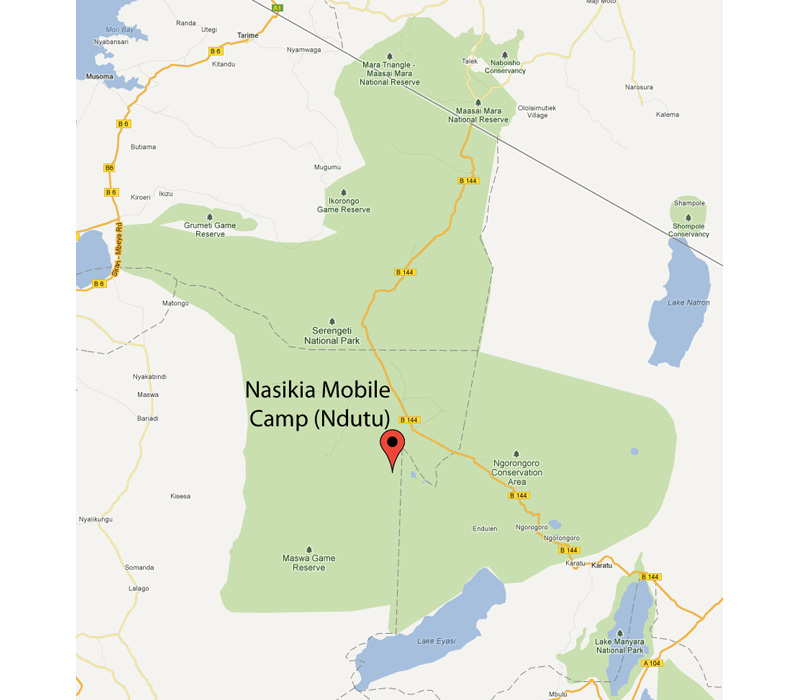
Tanzanian map
The advantage of visiting multiple parks in a single trip is that you can frame similar subjects (e.g. lions) against different backdrops since each park has its own fauna and unique characteristics. Conversely, the advantage of shooting multiple days in a single park is that you can track animals and observe their behaviour and potentially be in a position to see something pretty spectacular (e.g. a kill, a birth, fights etc). For those who have never been on a safari or who aren't avid photographers, I would suggest you do the former first.Daily highlights (and a mystery is finally solved!)
Back to the topOne of the big mysteries after many trips to Africa has to do with kilometers driven. There are no gas stations in the Serengeti, yet, on my last trip, my wife and I were in the jeep at one point for 12 hours a day over the course of 4 straight days. Are the land cruiser's gas tanks that big? Is there spare gas at the camp site? Or is it an illusion in that we simply don't drive that far in a day?
To solve the mystery, I brought along an old GPS. Here's a quick summary of the trip including distances travelled:
Day 1: Arusha to Ngorongoro Crater - game drive - Rhino Lodge(Click to see map)
Back to the topThe total distance travelled on day 1 was roughly 240 kilometers over the span of about 9.5 hours. The game drive itself lasted a little over 6 hours and covered roughly 75 kilometers.
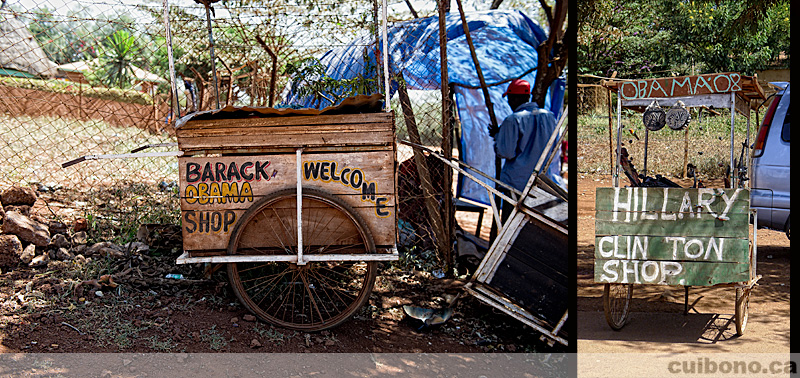
The Obama and Clinton shops located on the way to the Crater

Anybody want a Sumsung, Simens or Motorolar phone?
The game drive was good. We saw animals including zebras, ostriches, various birds, lions, cheetahs, elephants and rhinos from afar.
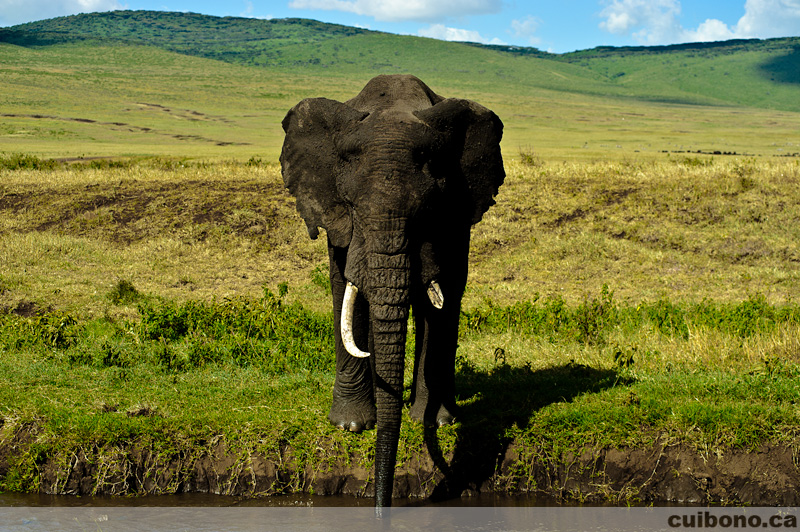
Elephant in the Ngorongoro Crater
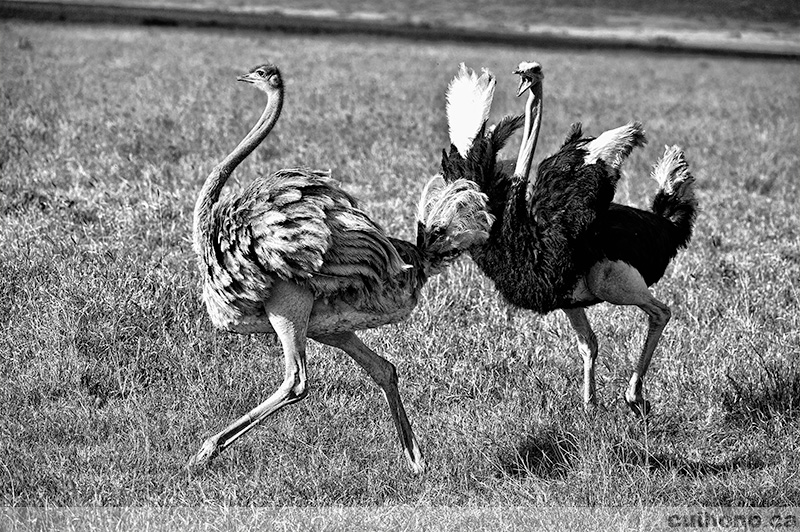
Ostriches in the Ngorongoro Crater
We arrived in the crater at mid-day which meant that the animals were not very active. This and the mid-day light made for difficult photographic conditions. Moreover, I'm not a big proponent of the Ngorongoro Crater because I find the area too expansive without enough roads to service it properly. Animals are often far and when they come close, you have no way to re-position yourself properly to get the angle you want.
Day 2: Rhino Lodge to Ndutu - all day game drive (Click to see map)
Back to the topThe total distance travelled on day 2 was roughly 140 kilometers over the span of about 11 hours. We traversed the Serengeti to get to Ndutu during the 11 hours so in reality, the whole day was a game drive.
The day quickly started off on an exciting note. We "stalked" giraffes on foot (what nimble and inquisitive creatures) and saw a hyena eat and move his kill around. The rest of the day was just as good as we saw typical animals including lions, cheetahs and zebras. The animals were thankfully a lot more active and consequently more photogenic throughout the day. All in all, I can't say that I've ever been disappointed while in the Serengeti and day 2 reaffirmed that feeling.
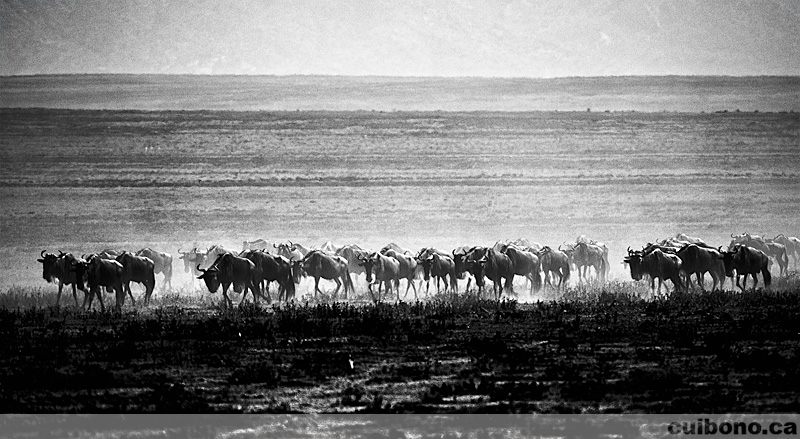
Wildebeest on the move in the Serengeti
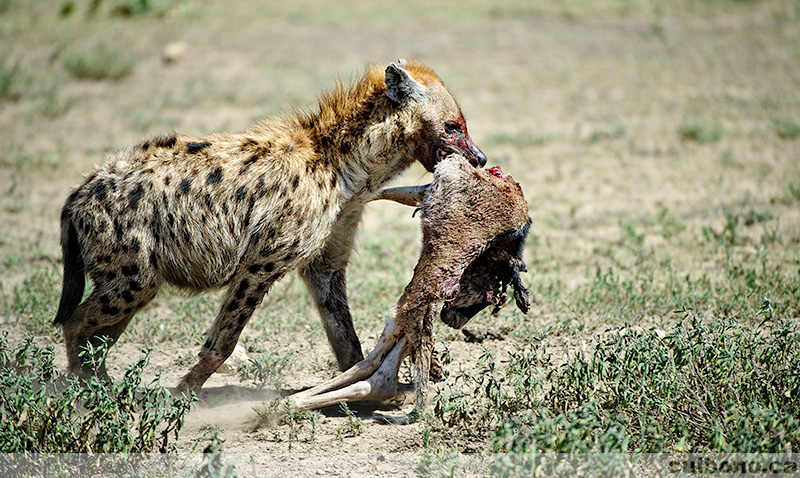
Hyena moving his kill in the Serengeti
Day 3: Nudtu - game drive (Click to see map)
Back to the topThe total distance travelled on day 3 was roughly 35 kilometers over the span of about 13 hours. Yes, you read that correctly. Our car moved only 35 kilometers in 13 hours.
Day 3, much like day 2, started off with a bang: we saw a pride of lions eating their fresh kill and play fighting. We were first on site and had incredible unimpeded angles for about 30 minutes. If you are planning a trip, the best advice I can give you is this: wake up early and get into the park as soon as possible.
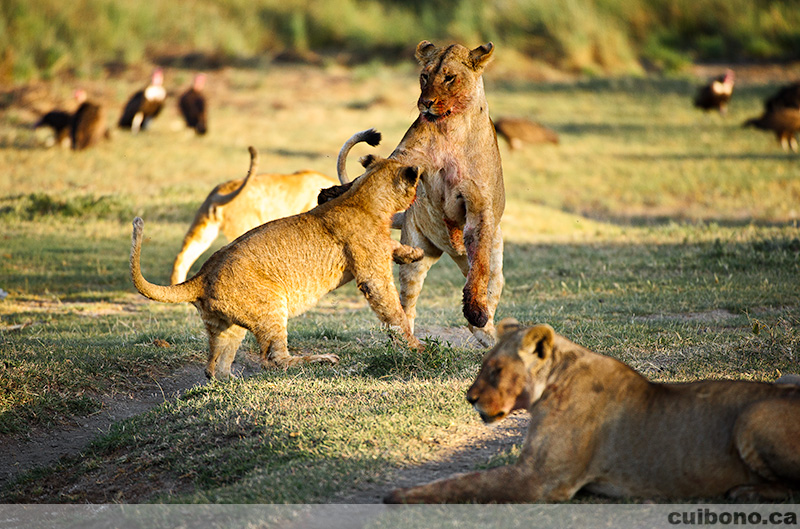
Playful lions in the Serengeti
We observed and photographed them for a few hours. We eventually left them alone and had breakfast in the jeep, only to find out shortly after that a pregnant wildebeest nearby was about to give birth. We quickly tracked her down and followed her from afar. Unfortunately for her, the leader of the herd kept running, which meant she had to follow even though her baby's legs were already partially sticking out. The herd eventually stopped which allowed the expectant mother to lay down by a tree to give birth. In the picture below, look at the female wildebeest positioned to the left - you should be see the little feet dangling.
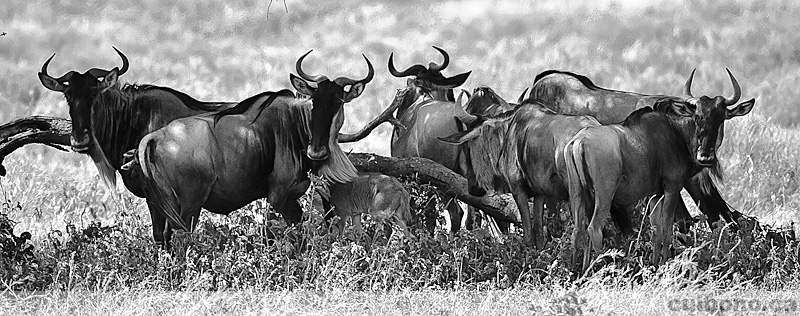
Wildebeest giving birth in the Serengeti
The baby was adorable and became surprisingly deft at walking after a couple of false starts.
The birthing spectacle was followed by a very relaxing afternoon under a tree next to three (lazy) cheetah brothers. We were hoping that they would hunt, but after a false start, they simply decided to relax and enjoy the shade a little while longer. We relaxed as well and took pictures of majestic birds before eventually heading back to the camp.
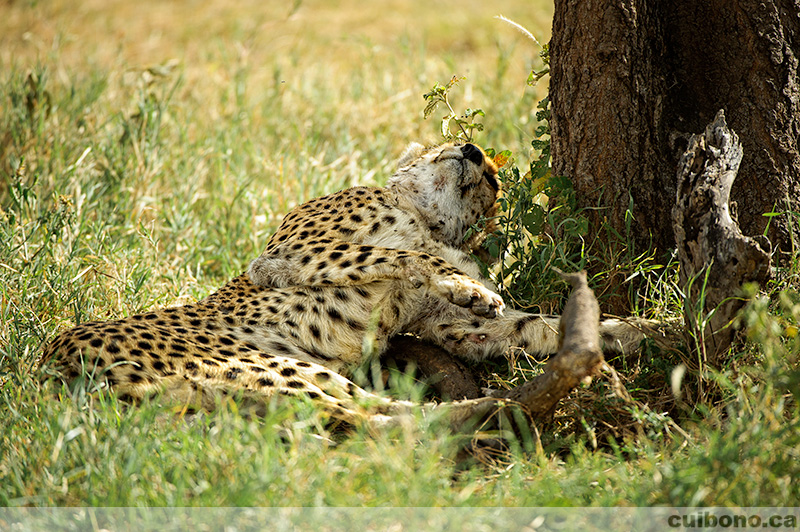
Lazy cheetah in the Serengeti
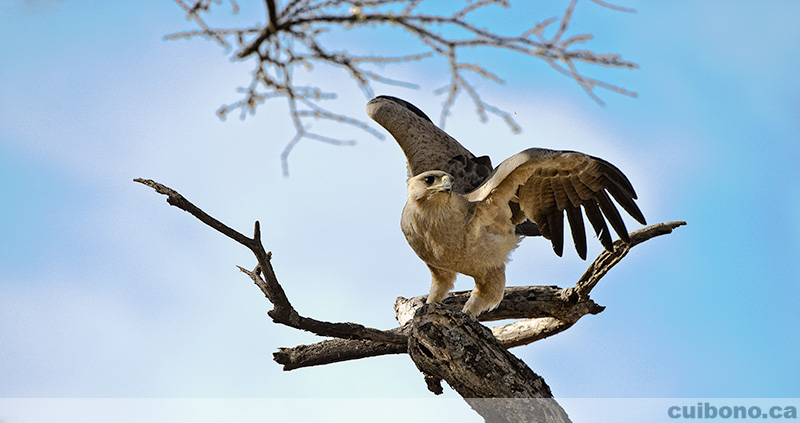
Eagle in the Serengeti
Day 4: Ndutu - game drive (Click to see map)
Back to the topThe total distance travelled on day 4 was roughly 80 kilometers over the span of about 13 hours. Having already seen all of the major animals (apart from the leopard) and having witnessed some incredible moments (lions eating, birthing etc), we set out to look for something new: a kill. Due to a variety of reasons, we believed that the three cheetah brothers from day 3 had probably not eaten yet. We left the camp site extremely early, and under the moonlight, set out to find the three brothers. Unfortunately for us though, the lack of light proved to be our Achilles heel as we could not find them in the morning. We did run into them later in the day however, but again, they appeared to be tired and not hungry.
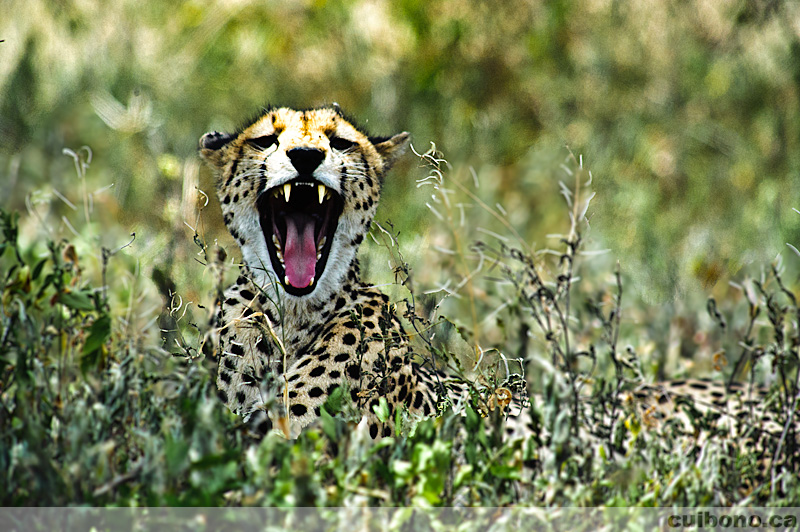
Cheetah in the Serengeti
The day wasn't a write-off however. We did manage to see a leopard as well as the usual suspects (i.e. zebras, hyenas etc). Our guide also helped out a fellow driver who brazenly decided to drive through a thick patch of mud. His jeep got stuck, and our driver, being the good Samaritan that he is (despite initially telling the driver not to drive through the mud patch), helped winch the jeep out of its sticky situation (pun intended).
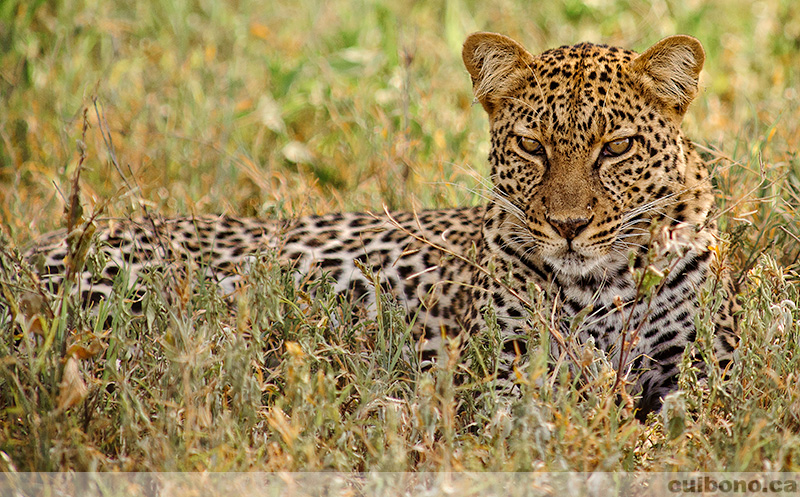
Leopard in the Serengeti
The day ended on a high note again as we came across the same pride of playful lions. They again had recently killed and were enjoying their meal (and looking for more). We parked the jeep and just observed them. It's important to put the camera down every so often and just take it all in.
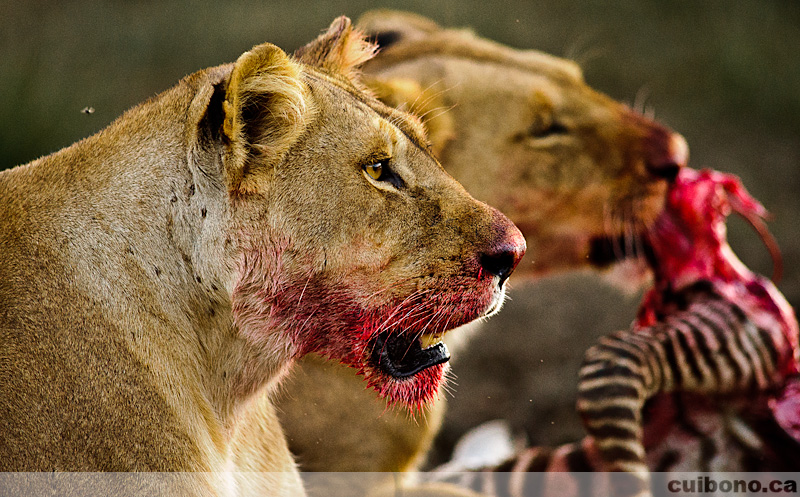
Hungry and focused lions in the Serengeti
Day 5: Ndutu - game drive(Click to see map)
Back to the topThe total distance travelled on day 5 was roughly 80 kilometers over the span of about 13.5 hours. The male lion, whom we could hear all night, finally made a cameo alongside his pride and briefly appeared for everyone to see. It didn't last long unfortunately, and before we knew it, he was gone. Lucky for us, it wouldn't be the last time we'd see him...
We moved on from the pride of lions and observed a lone cheetah hunting. Unfortunately for us, the lack of respect for animals displayed many tour guides created adverse conditions for the hunting cheetah. Drivers, perhaps at the behest of their clients, continually drove up to the cheetah so that the tourists could take pictures. This lack of respect caused potential preys to continually notice the cheetah. He therefore had to walk on in the hopes that he would be left alone to hunt. His wish was eventually granted, though at this point, he only managed to kill a skinny hare instead of a Thompson gazelle or better. Godwin, Aaron and myself were furious since we were powerless throughout the situation. Godwin did warn the other drivers via his radio, but many simply ignored him.
This sad experience, which has happened to me in the past, was thankfully followed by an incredible one. We found four baby cheetahs, all eating the small animal their mother had killed moments prior to our arrival.
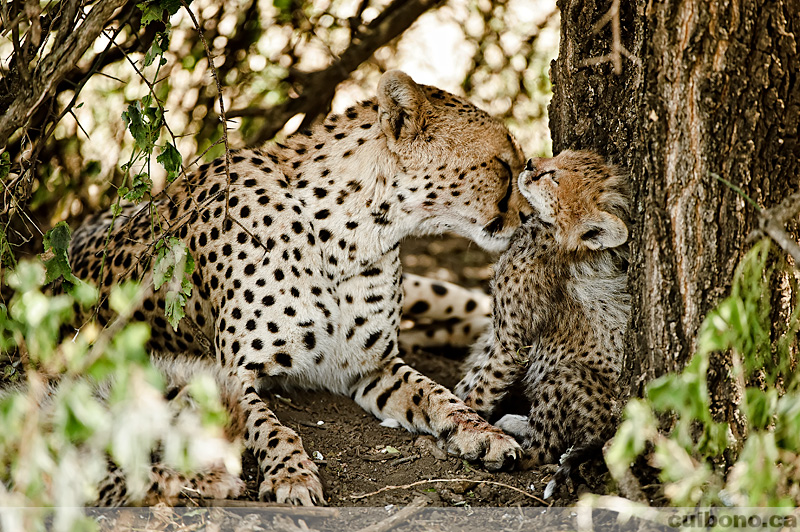
Mother and baby cheetah in the Serengeti
Baby cheetahs are very difficult to find since they are usually hidden in holes or in thick brush by their mothers until they are older. It goes without saying that we were extremely lucky. The babies ate to their heart's content and washed down the fresh meat with some breast milk. Once full, the mother cheetah cleaned off her babies, one at a time, and before you knew it, it was bed time for the young family.
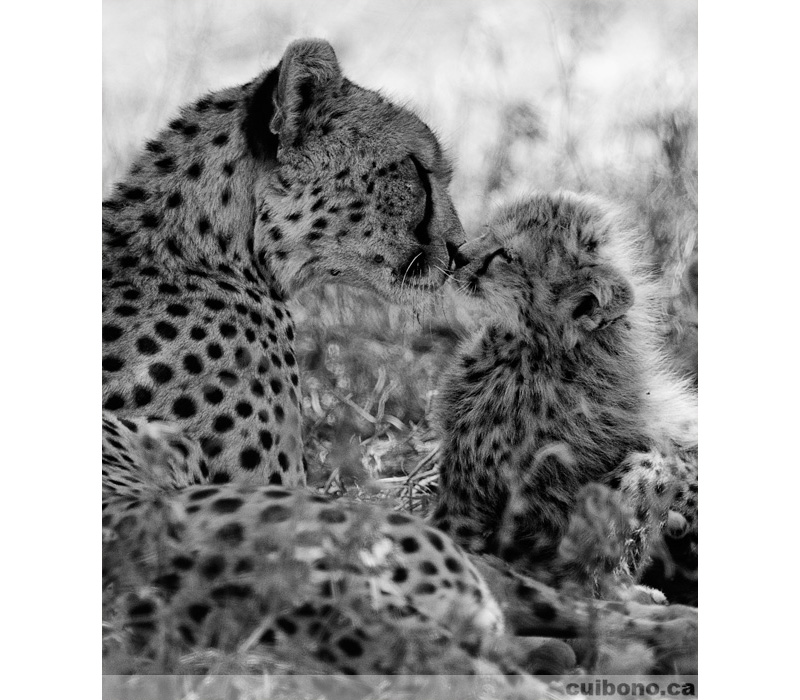
Mother and baby cheetah in the Serengeti
We spent a couple of hours watching all this unfold. After lunch and a little power nap, we decided to drive to Lake Masek so that Aaron could see and hear hippos. On our way there, Godwin noticed a chameleon. I'm still not sure how he noticed the chameleon since we were going fast and dust was everywhere.
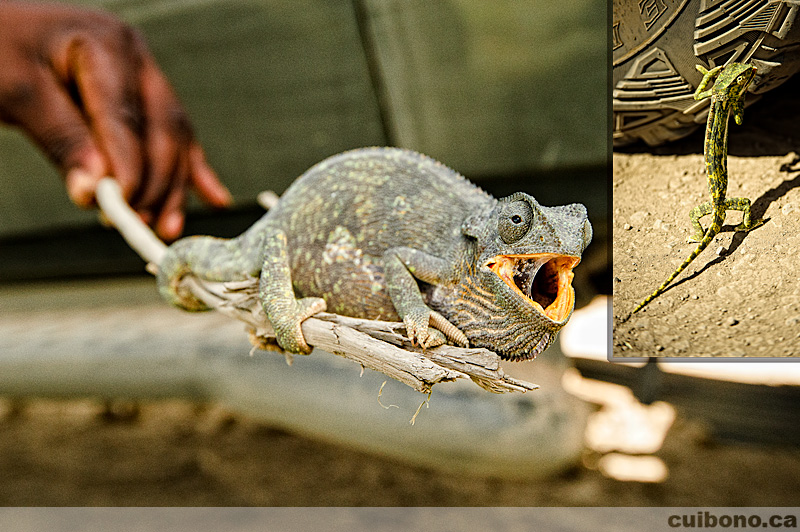
Chameleon (notice the color change)
A little further down from the chameleon was a small herd of elephants dusting themselves. We eventually made it to Lake Masek were we saw and heard hippos, as well as flamingos.
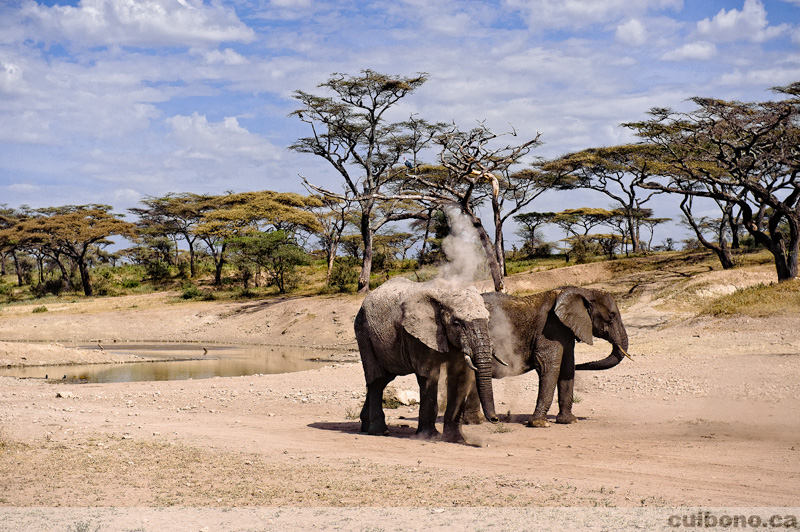
Dusty elephants in the Serengeti
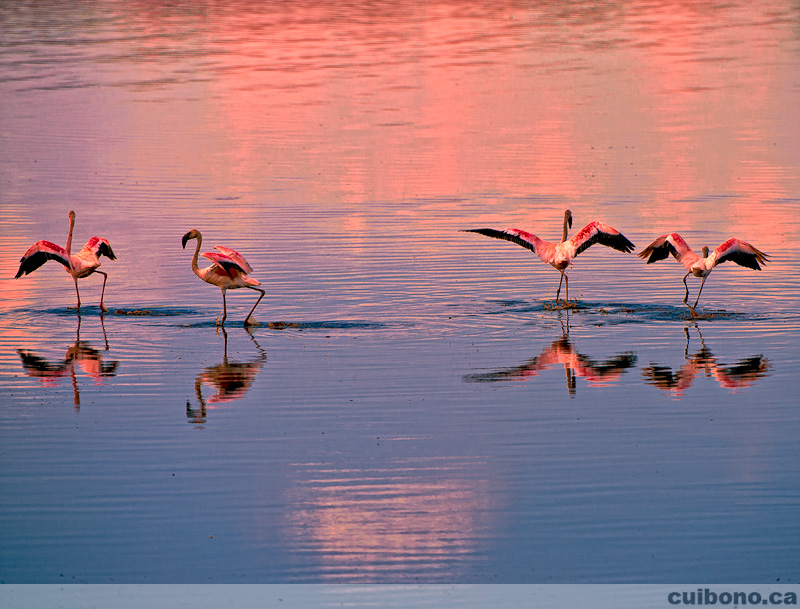
Flamingos in Lake Masek, in the Serengeti
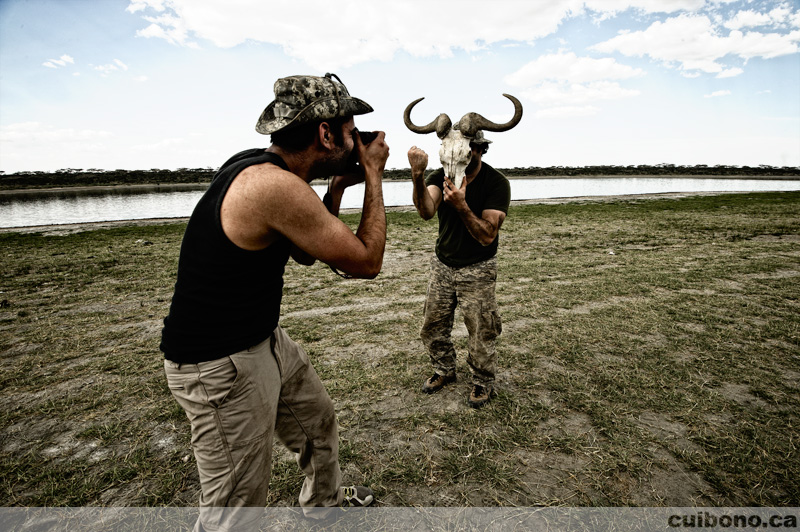
Rob and Aaron acting silly at Lake Masek, in the Serengeti
The day ended once again next to the pride of lions. We could have watched for a few hours but since it was our last night, we had to be on our way so that we could pack. On our way back, we took a small detour to catch one last glimpse of a Serengeti sunset. Fortunately for us, elephants decided to cross right in front.
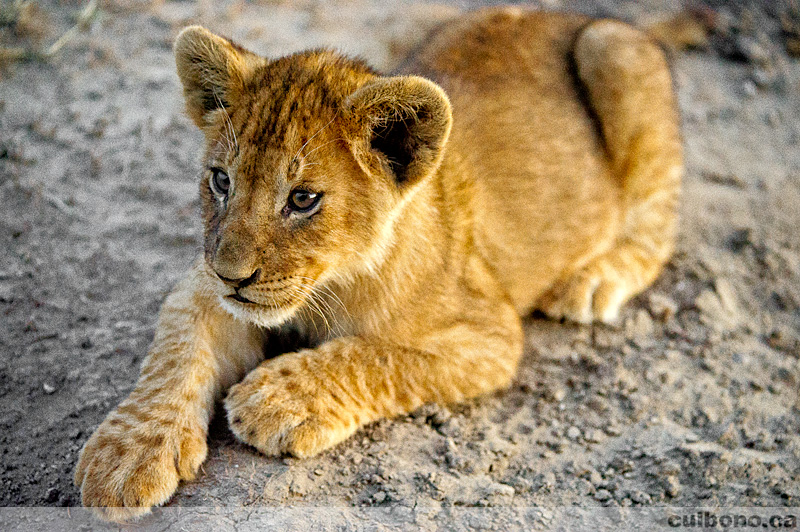
Lion cub in the Serengeti
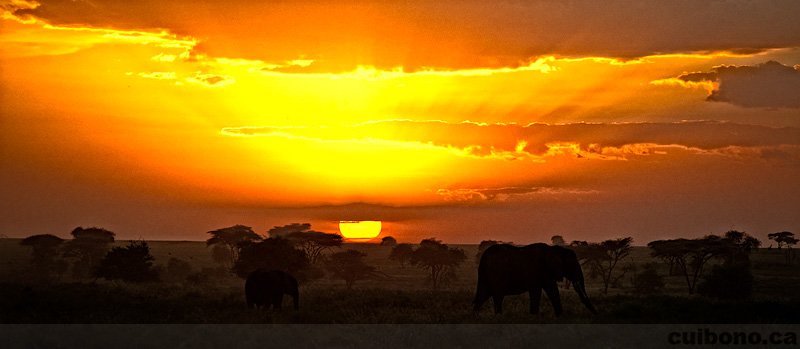
Sunset in the Serengeti
Day 6: Ndutu - game drive - Ngorongoro Crater exit (Click to see map)
Back to the topThis first part of day 6 covered roughly 130 kilometers in about 4 hours. The game drive portion of the day was only one hour and covered no more than 10 kilometers. So what did we see in one short hour?
Perhaps to wish us bon voyage, the male lion came out again. Instead of a brief cameo, he walked over to the river to have a quick drink, then called the rest of the pride over before laying down in the open. It was a great send off and after photographing the rest of the pride (again), we were off.
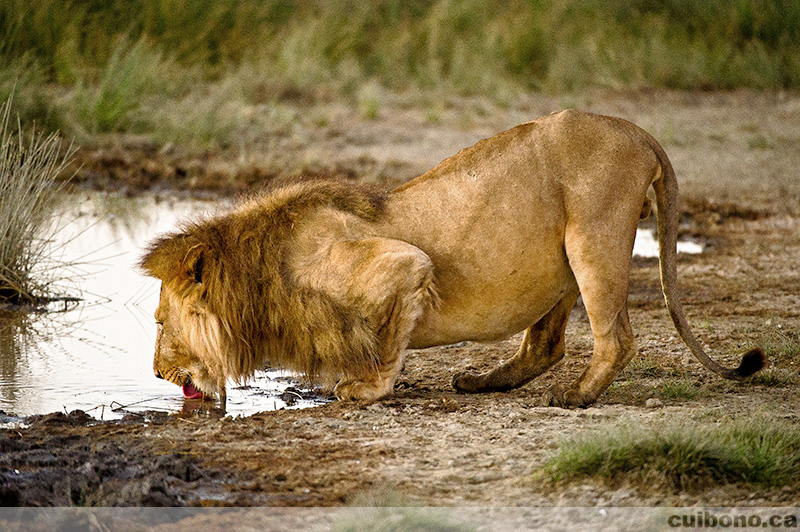
Lion male in the Serengeti
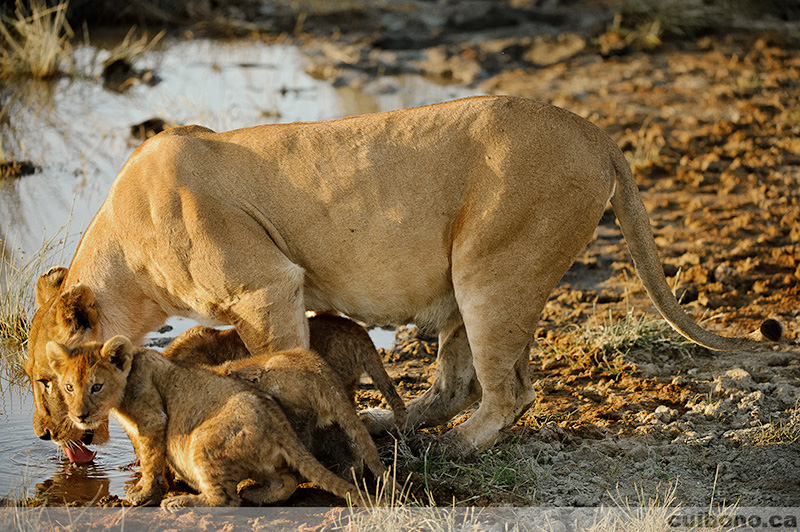
Lion female and cubs in the Serengeti
Day 7: Ngorongoro Crater exit - to Arusha - to Nairobi (Click to see map)
Back to the topOnce out of the Crater, it was onto Arusha to catch my bus to Nairobi. I can honestly say that after so many 12 hour days in the scorching heat, all I really wanted was a long shower and a comfortable bed so that I could rest before my trip back to London. The trip from the crater to Nairobi took a little over 9 hours and covered close to 450 kilometers. Meanwhile, Aaron was on his way to Dar Es Salaam by plane. I'm sure he felt the same way.

Kids at a pit stop while in transit to Nairobi
Summary
Back to the topSo just how many kilometers did Godwin, Aaron and I average per day on our trip? On an average 12 hour day, we covered 88 kilometers, or 7 kilometers per hour.
Game drive conditions
Back to the topLike every other trip to Africa, it was incredibly dusty. Moreover, oncoming jeeps made things worse since we inevitably drove into their dust cloud. Out of all my trips to Africa, I think this was the dustiest (my lenses and cameras can attest to it - see below).
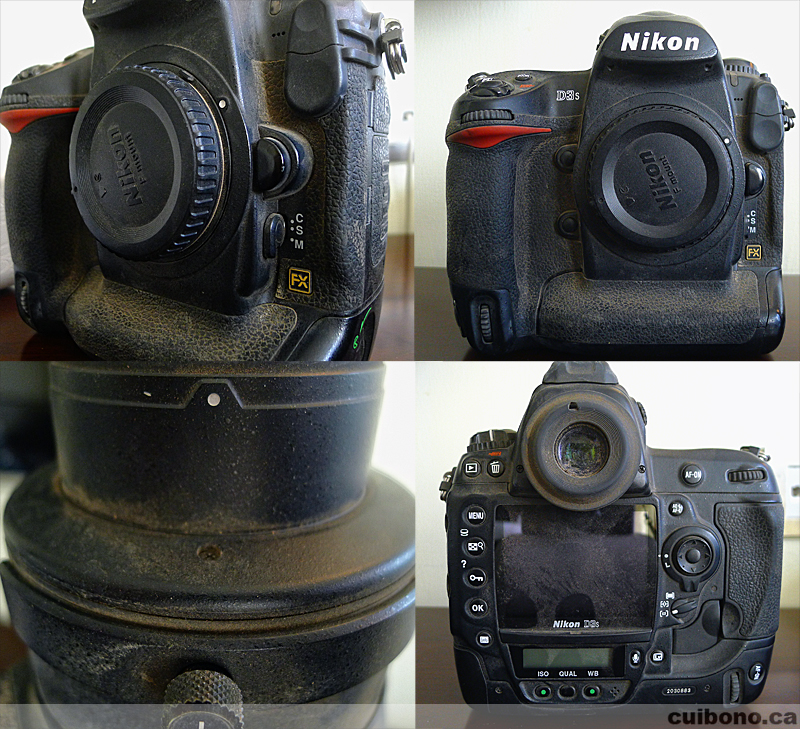
Dusty D3s
That said, nothing that Nikon and my local camera store couldn't clean up once I arrived at home. Both Aaron and I took the necessary precautions when changing lenses (point the camera body down, do it quickly) and when in transit, I usually had a cover on my gear. I say usually because often, we'd go from one area to the next very quickly and neither Aaron nor I had a chance to even sit.Compounding the dust problem was the type of jeep we were in. Ours was one without a pop top. Instead, we had a removable tarp which pretty much stayed open from dawn to dusk. The advantage of a land cruiser with a tarp roof is that once the roof is rolled back, photographers have unimpeded sight lines in every direction. Land cruisers with pop tops restrict your ability to track anything overhead. The downside of not having a pop top of course is the additional dust and of course, the sun. We were baking in the sun from morning to night.
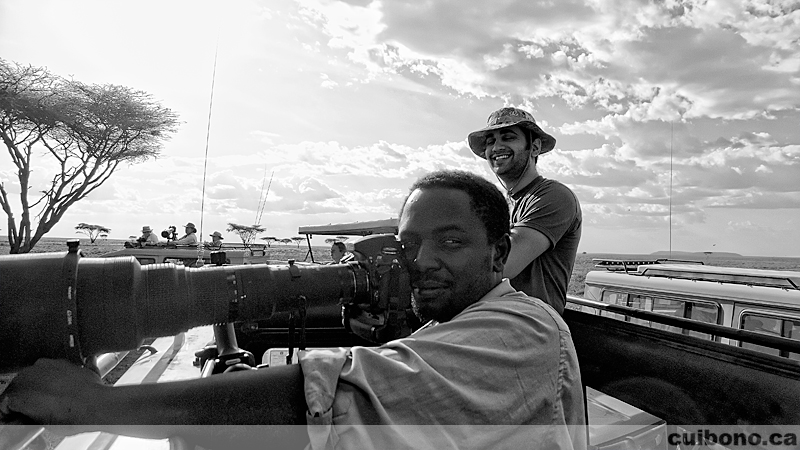
Open top land cruiser: Godwin and Aaron
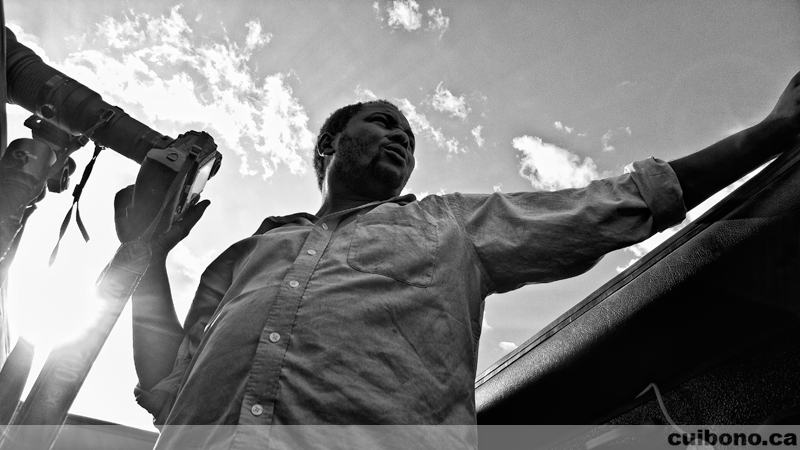
Nothing but a clear sky above us
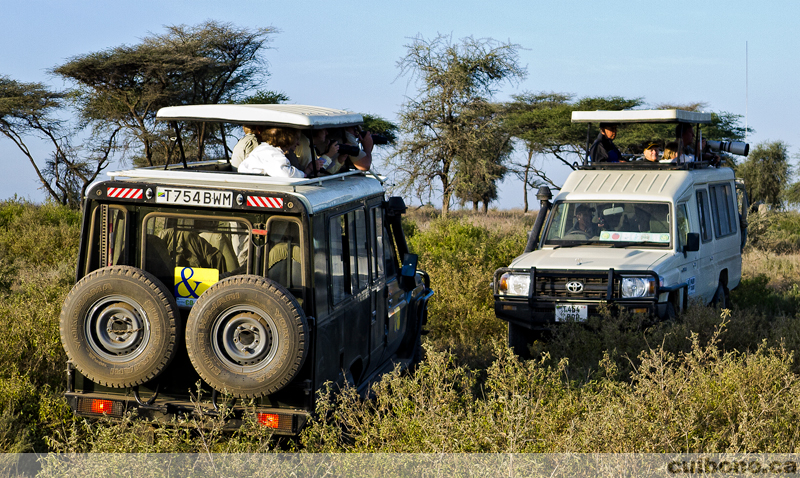
Crowded land cruisers, both with pop tops
The sun burn issue can however be quickly resolved (and prevented) as long as you have a hat, a lot of sun screen and enough water to keep you hydrated throughout the day. The effect of the sun on the other hand, on top of the amount of time spent lifting heavy lenses and contorting oneself into awkward positions in order to capture a moment, eventually tires you out. Even though we never went back to our camp to rest and to eat lunch at mid-day, we certainly did find appropriate moments while in the field to stop, eat, and relax.
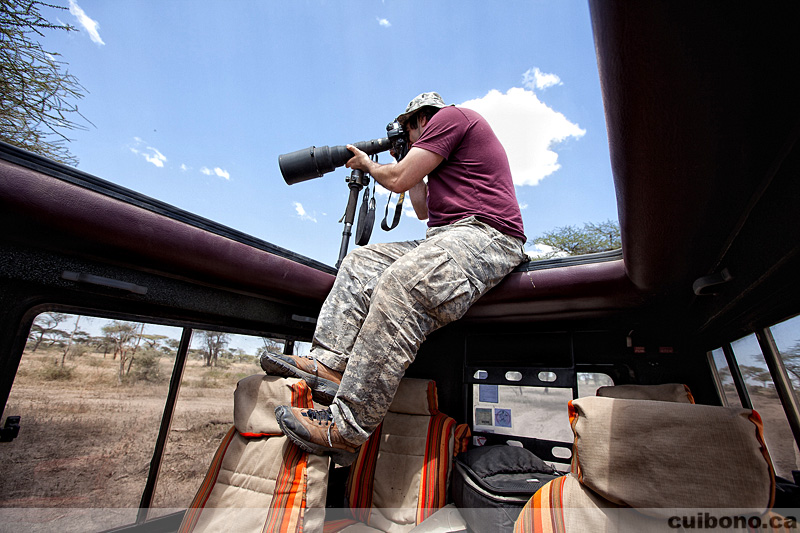
Just trying to get the shot (Robert Hawara)
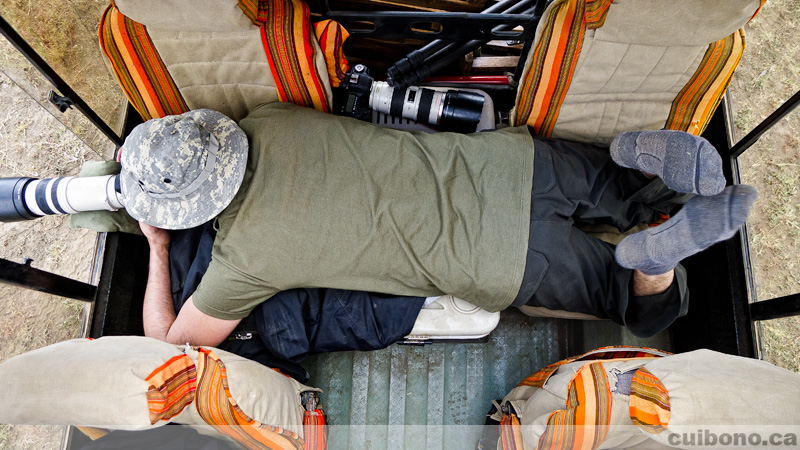
Just trying to get the shot (Aaron Rodericks)
Lastly, the mosquitoes were virtually non-existent. Flies on the other hand were everywhere and were not afraid to get in between you and your viewfinder. They were unbelievably annoying, and if it wasn't for Aaron's catnip spray, it could have really adversely affected portions of the trip. They were that bad.
Camera equipment
Back to the top
As I noted in my Kenyan safari post-mortem, a moment can never be captured twice: once it has passed, it is gone. As a photographer (amateur or not), it is important to bring with you the most appropriate camera equipment you can afford and carry if your ultimate goal is to capture long lasting memorable images. That's not to say that you need to buy the equipment: renting is definitely the more sensible option if you're not planning on doing many in your lifetime.

Camera equipment
You should note that the above sentence has the words "and carry" emphasized. That's because you can buy or rent the biggest lenses in the world, but bringing them onboard (along with the equally large tripod and the rest of your equipment) is a different story altogether. The risk is that you may encounter a grumpy or over-zealous gate agent who will ask you to check your expensive lens in the plane's baggage hold. So unless you live next door to the game area, if you are coming from far away, you have to find the right balance between "the best equipment" and the "most appropriate equipment". Verify your airline's baggage allowance policy and if you're as worried as I was, call them.
With that said, let's get down to the gear that I brought along.
Cameras
| Camera | # of actuations | Notes |
| D3s | 8,321 (60%) | Big, heavy and not inconspicuous. Incredible at high ISOs which were needed when coupled with the 200-400 F4. It was my main camera throughout and it performed impeccably. |
| D700 | 5,224 (40%) | Along with the portrait grip, the 80-200 was attached to it 80% of the time. Great camera which complimented the D3s very well. Like it's big brother, it performed impeccably. |
| Lumix LX5 | NA | Discreet camera that was used extensively to document the small things that happened while on safari. I didn't make good use of it previously, but I was much happier with it this time. |
I've been using my D3s for a while now and it continues to amaze me. It has allowed me to capture moments at all hours of the day and night, including the picture below.
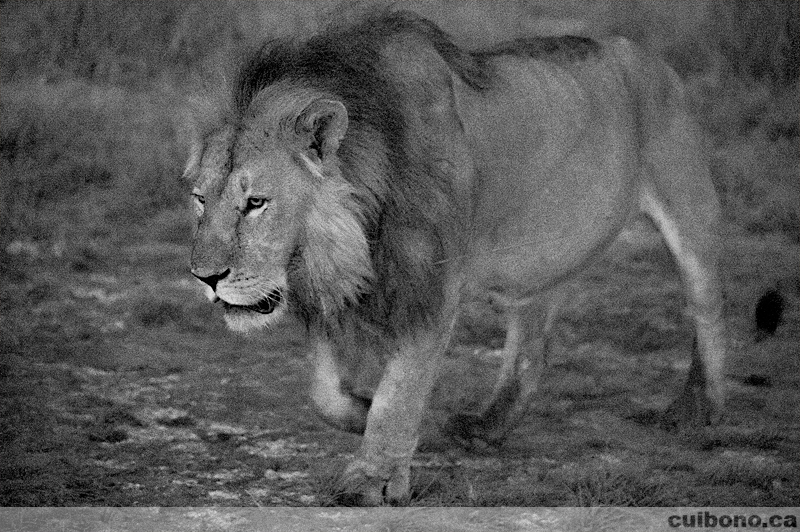
The lion king, pictured 15 minutes before sunrise at ISO 102,400
The picture itself won't win any prizes, I'm just adding it to illustrate a point: having the ability to shoot at such high ISOs can come in handy once in a while, if only to capture a moment for yourself. The D700 was also fantastic, it did a great job as my second camera.
In terms of ISOs, this trip was very different when compared to my trip to Kenya (see Kenyan equipment post-mortem). This time around, I used my D3s a lot less at ISO 800 and higher (55% of the time instead of 90%) and I used my D700 a lot more at ISO 800 and higher (75% of the time instead of 5% of the time). The reason why is quite simple. My 500mm F4 lens (with and without TC) was on the D700 most of the time while in Tanzania instead of the 80-200mm. The 80-200mm at its maximum focal length is one stop brighter and 300mm shorter than the 500mm F4 (when a TC is attached, it's 2 stops brighter and 520mm shorter). Consequently, shutter speeds had to be increased and since I had to shoot mostly wide open, I had no choice but to increase my ISOs.
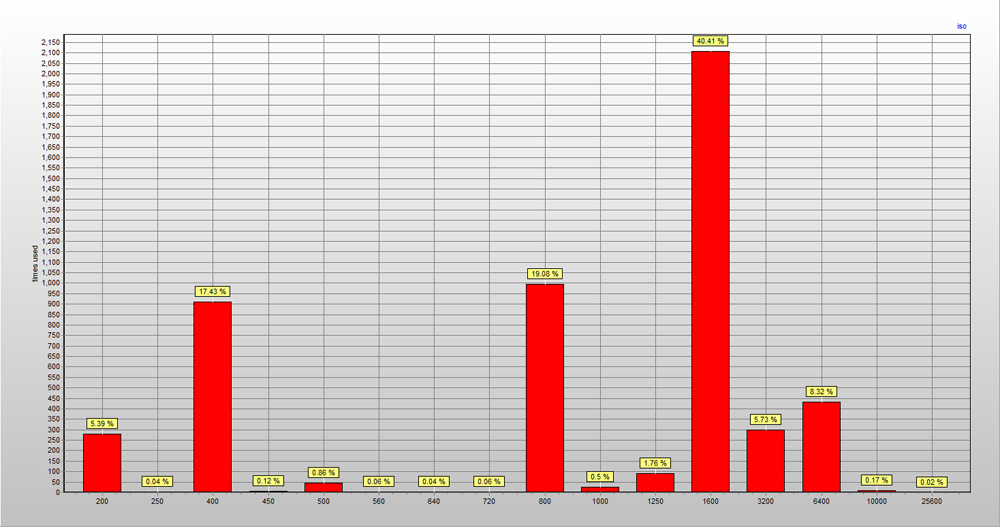
D700 ISO distribution
The D3s was used in many more situations and with many more different lenses when compared to the D700. This accounts for the more balanced ISO distribution.
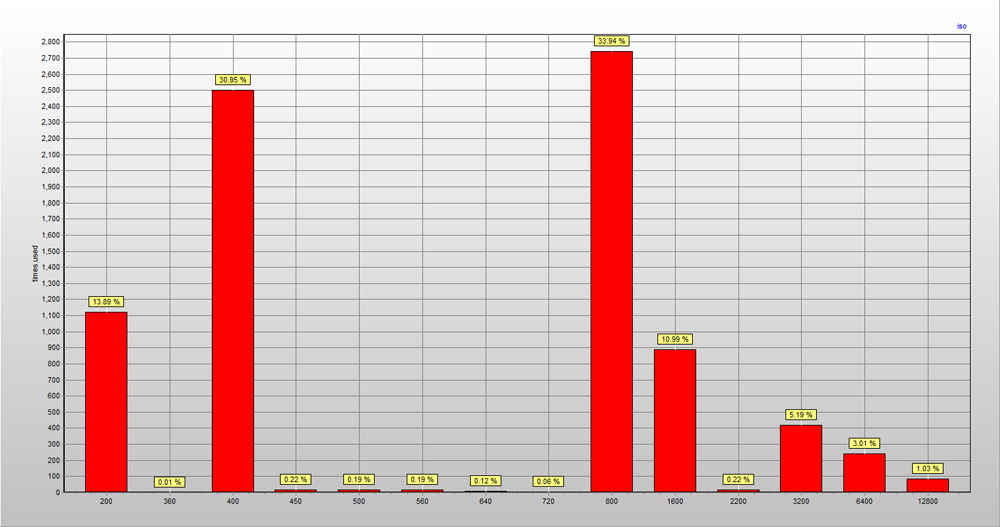
D3s ISO distribution
Lastly, the chart below outlines what the focal length to ISO ratio was throughout the trip.
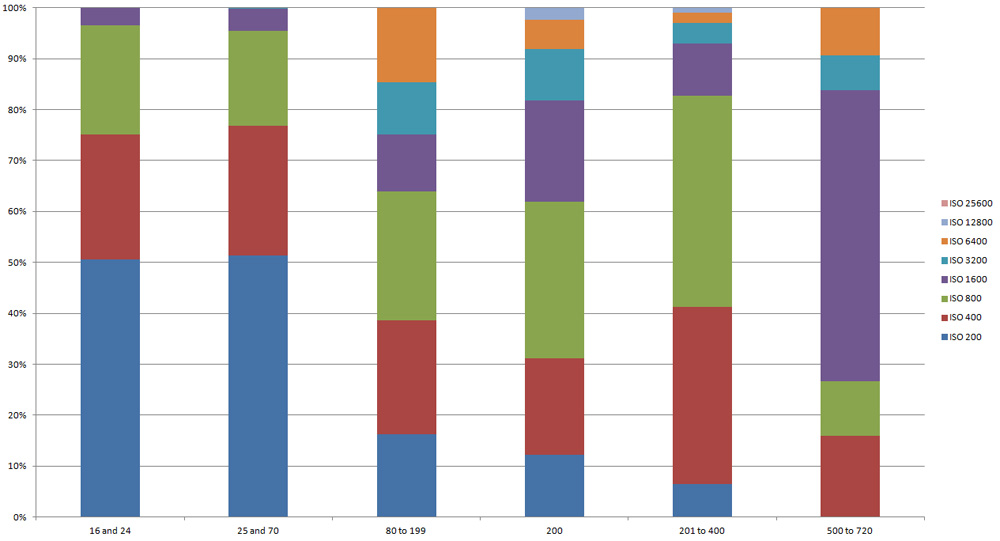
Focal length to ISO
Lenses
| Lens | Used? | Notes |
| 16-35 F4 | Yes | Used sparingly to capture panoramic pictures. |
| 24-70 F2.8 | Yes | Used sparingly to capture panoramic pictures. |
| 80-200 F2.8 | Yes | Used often for animal and panoramic pictures. |
| 200-400 F4 | Yes | Primary and most often used lens on my D3s during game drives. |
| 50 F1.8 | Yes | Used it to capture scenic moments while in transit between Arusha and the Ngorongoro Crater. |
| 50 F1.2 | No | NA |
| 105 2.8 macro | Yes | Used a handful of times |
| 500 4 (AI-P) + TC 1.4 | Yes | Primary and most often used lens on my D700 during game drives. |
As noted in the above table, the 200-400 F4 and the 500 F4 were used extensively throughout the trip. In fact, just as with my Kenyan trip, close to 90% of pictures were taken at a focal length equal or above 80mm.
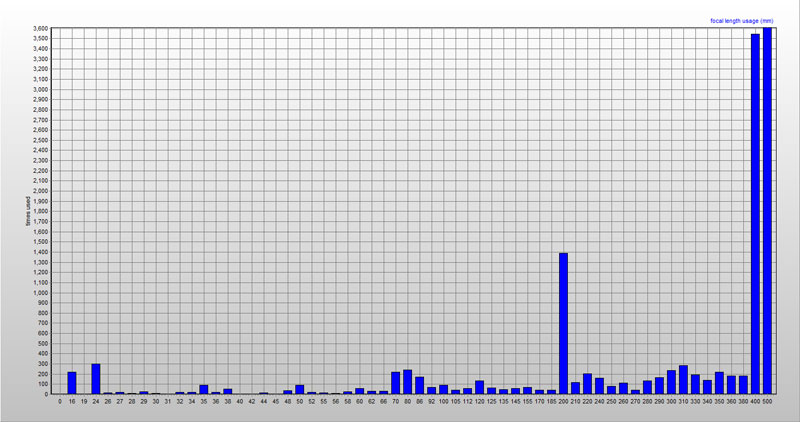
Focal length
That's not to say that I regret taking my wider lenses, but they are definitively used a lot less it seems when I'm in Africa. The areas we drove through were very expansive and many landscape shots required telephoto focal lengths in order to have a large enough subject in the frame. Moreover, to me, a successful wide angle picture usually requires that a subject be near you, and that you take the photograph at an interesting angle. The ability to have something interesting that close to you, with a nice backdrop at a nice angle are few and far between unfortunately. You are somewhat restricted in your movements while in the field.
The 500mm F4 AI-P was a fairly new addition to my lens arsenal before leaving. I picked up a great copy at a very reasonable price a month before leaving which gave me time to test it out locally before leaving. I bought the manual focus version instead of auto-focus version because from past experience, I knew that there were many opportunities to photograph static animals (in fact, most animals that you'd want to photograph are most of time static or slow moving). Since I had the 200-400 F4 attached to my D3s, it was easy to switch if I needed reach and auto focus. Moreover, I was able to focus the lens fairly easily given the D700's large viewfinder. I will be bringing it back as it is a nice light and portable telephoto option (relatively speaking).
Overall, I'm happy with the lenses that I brought with me. Next time, if I know that I have no planned trips into a city, I will leave the 50mm 1.2 at home. I can't however see myself leaving behind any of the other lenses listed as they all served a purpose. The above mix is perfect as it covers me with fast glass from 16mm all the way to 720mm with little to no overlap. The only additional accessory that I will bring next time is a modified TC-16A to help turn my 500mm F4 AI-P into a semi-AF lens and maybe a 16mm fisheye (the lens is too much fun to leave behind).
Accessories
| Accessory | Used? | Notes |
| Netbook | Yes | A necessity, crucial part of your backup strategy. |
| External hard drive | Yes | A necessity, crucial part of your backup strategy. That said, I should have taken a second one with me. |
| CF cards | Yes | Brought enough along to compliment the external hard drive: 4*32GB, 2*16GB, 3*8GB, 2*4GB |
| Batteries | Yes | Of course - extra batteries for every camera. |
| Monopod | Yes | Used it a lot more than when in Kenya because of the 500mm F4. |
| Wimberley sidekick | | Used it a lot more than when in Kenya because of the 500mm F4. |
|
| SB-900 | No | Never needed |
| Bean bags | Yes | Supplied by my excellent guide Godwin, they were of course indispensable. |
| Binoculars | Yes | Really useful. |
The only thing I regret is not taking a second external hard drive. My usual backup up strategy is to put all pictures onto the external hard drive and to also remove the memory cards from the rotation. This allows me to have two backups. But I was taking pictures at such an alarming rate that by day 3, I was running out of cards and had to go without a backup strategy (the netbook's hard drive is not very large). I was very worried while traveling home since all my pictures were on a single hard drive, which meant I had a single point of failure. Luckily, nothing happened and I've since backed up my pictures at home.
The other interesting thing that happened accessory wise was Aaron's battery charger breaking down (blown fuse we believe). Lucky for him, someone else was shooting Canon and was generous enough to let him charge his batteries overnight. I'll probably start packing a second charger from now on since that too is a single point of failure.
Final thoughts
Back to the topThe trip was a success. It was Aaron's first game drive and he also thoroughly enjoyed it. I still haven't seen a kill though (trust me, we were looking), but in the grand scheme of things, I'm not all that flustered about it. I was able to see some extremely memorable scenes, and for what it's worth, I still have a reason to go back.
The one thing that continually bothered us (myself, Aaron and Godwin) was the complete disregard and disrespect for the animals by some drivers. Off-roading in some areas in the Serengeti is forbidden which often means that animals will be pretty far from the tourists. The advantage is that the animals can hunt in peace. In Ndutu, drivers must exercise good judgment since they are allowed to go off-roading. This means that they are not to interfere with the animals. Far too often however drivers drove right next to them in order to allow the tourists to take pictures and view them from up close. That's problematic for a couple of reasons, which I'll illustrate using two examples:
- We saw a majestic leopard on day 4. There were many land cruisers parked around the area, but everyone kept their distance and turned their engine off in order to not scare the leopard. She was comfortable when all of a sudden, two drivers decided to drive within a few feet of the leopard so that the tourists onboard could get a close up of the animal. The leopard was understandably startled and immediately hid. The action of the two drivers impacted every other person who was watching the leopard. This happened on day 6 as well, but with lions this time. The driver was not paying attention and nearly hit two lions while crossing the road. The startled lions ran and dodged the land cruiser in time.
- As noted above, a handful of drivers would not let a cheetah hunt in peace. They would continually drive near her. Their actions alerted nearby would-be-prey of the cheetah's presence. She in the end only killed a small hare instead of a much larger animal, which she desperately needed for sustenance. Their disregard for the cheetah's well being could very well impact her health.
The safari company that was responsible for these violations is called Leopard Tours. If I could urge you to avoid one company, it would be that one.
Thank you for reading.
